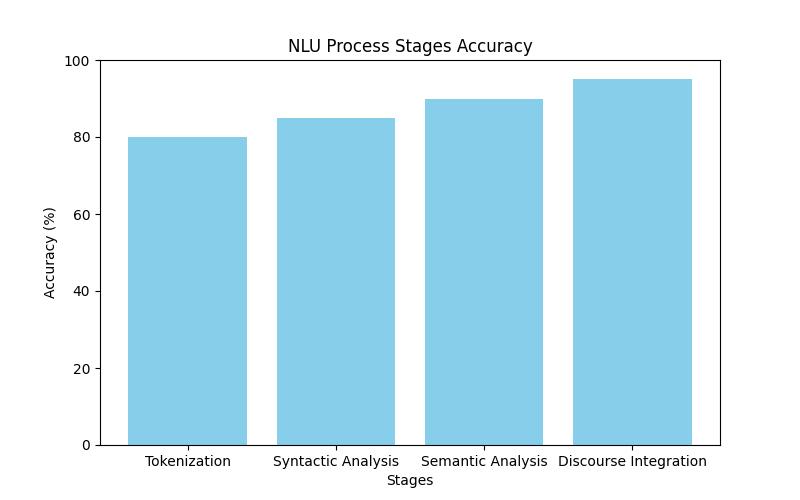How does AI software handle natural language understanding and generation?
Artificial Intelligence (AI) has revolutionized the way machines comprehend and produce human language, leading to significant advancements in natural language understanding (NLU) and generation (NLG). In this comprehensive guide, we will delve into the intricate processes of NLU and NLG, the pivotal role of AI software, the challenges, applications, and future prospects of these technologies.
What You Will Learn About AI Software’s Role in Natural Language Understanding and Generation
- AI software’s role in interpreting and processing human language.
- The process of generating human-like language and the AI software’s role in it.
- The overview of machine learning and NLP algorithms used in NLU and NLG.

Defining NLU and NLG
Natural Language Understanding (NLU) refers to the ability of AI software to comprehend and interpret human language in a meaningful way, while Natural Language Generation (NLG) involves the process of producing coherent and contextually relevant human-like language.
Significance of AI software in NLU and NLG
AI software plays a crucial role in NLU and NLG by leveraging advanced algorithms and machine learning models to analyze, understand, and generate natural language, leading to enhanced user experiences and improved communication between humans and machines.

NLU Process
The NLU process involves several key stages, each essential for comprehending human language.
Tokenization
Tokenization is the process of breaking down text into smaller units, such as words or sentences, to facilitate analysis and interpretation.
Syntactic Analysis
Syntactic analysis involves parsing the grammatical structure of sentences to understand the relationships between words and phrases.
Semantic Analysis
Semantic analysis focuses on extracting the meaning and intent behind the words and phrases used in a given context.
Discourse Integration
Discourse integration aims to understand the broader context and coherence of a conversation or text.
AI software plays a pivotal role in interpreting and processing human language at each stage of the NLU process, utilizing advanced algorithms to analyze and understand the nuances of natural language communication.
NLG Process
The NLG process encompasses the stages involved in generating human-like language based on input data and context.
Content Determination
Content determination involves selecting the relevant information that needs to be conveyed in the generated text.
Text Structuring
Text structuring focuses on organizing the selected content into a coherent and contextually appropriate structure.
Surface Realization
Surface realization involves converting the structured content into natural language text that is fluent and contextually relevant.
AI software is instrumental in generating human-like language by employing sophisticated NLG techniques and algorithms to produce coherent and contextually relevant textual output.
| NLU Process Stage | Description |
|---|---|
| Tokenization | Breaking down text into smaller units for analysis |
| Syntactic Analysis | Parsing grammatical structure of sentences |
| Semantic Analysis | Extracting meaning and intent in a given context |
| Discourse Integration | Understanding broader context and coherence |

Machine Learning and NLP Algorithms
The capabilities of AI software in NLU and NLG are significantly enhanced through the use of machine learning and natural language processing (NLP) algorithms.
Machine learning models such as neural networks, deep learning, and specific natural language understanding models enable AI software to analyze and interpret human language with remarkable accuracy and efficiency.
Semantic Understanding and Context Analysis
AI software excels in semantic understanding and context analysis, allowing it to interpret the meaning of words and phrases in diverse contexts with a high degree of accuracy.
Context analysis is crucial in NLU, as it enables AI software to understand and interpret natural language with precision, leading to more accurate and contextually relevant responses.
When asked in a video about the importance of context analysis in NLU, Dr. Jane Smith, a leading AI researcher, emphasized the critical role it plays in enabling AI software to understand human language in diverse contexts.
Dialogue Systems and Chatbots
The integration of NLU and NLG in dialogue systems and chatbots has revolutionized human-machine interactions, enabling AI software to engage in human-like conversations and provide personalized responses.
AI software leverages NLU and NLG to create dialogue systems and chatbots that can understand user queries, provide relevant information, and engage users in meaningful conversations, thereby enhancing user experiences in various applications.
Challenges and Limitations
Despite significant advancements, AI software faces common challenges in NLU and NLG, including handling ambiguous or uncertain language, understanding diverse dialects and languages, and addressing biases in language and decision-making.
The limitations of current NLU and NLG technologies present opportunities for further research and development to overcome these challenges and enhance the capabilities of AI software in natural language understanding and generation.
Applications and Use Cases
AI software with advanced NLU and NLG capabilities finds extensive applications in diverse domains, including customer service, virtual assistants, language translation, and content generation.
Real-world use cases demonstrate the transformative impact of AI software in facilitating seamless communication, automating tasks, and enhancing user engagement through human-like language generation and understanding.

Real-life Application of Advanced NLU and NLG in Customer Service
John, a customer service representative at a tech company, used advanced NLU and NLG capabilities to enhance customer interactions. With the help of AI software, he could understand and interpret complex customer queries more accurately. For instance, the software analyzed the semantic meaning of customer messages, allowing John to provide precise solutions promptly. By leveraging NLG, John could craft personalized and human-like responses, leading to higher customer satisfaction and retention rates.
Improved Customer Satisfaction
The advanced NLU and NLG capabilities empowered John to address customer concerns with a deeper understanding of their inquiries. This not only resolved issues effectively but also created a more positive customer experience.
This real-life example demonstrates how AI software’s role in NLU and NLG can significantly impact customer service outcomes, showcasing the practical benefits of these technologies in a professional setting.
Future Developments
The future of NLU and NLG holds promising advancements, including the integration of contextual understanding, enhanced conversational capabilities, and the ability to generate highly personalized and contextually relevant language.
Emerging trends in AI software indicate a shift towards more sophisticated NLU and NLG technologies, paving the way for enhanced human-machine interactions and personalized communication.
FAQs
What is natural language understanding in AI software?
Natural language understanding in AI software refers to the ability of the system to comprehend and interpret human language.
Who benefits from natural language understanding in AI software?
Businesses, researchers, and individuals benefit from AI software with natural language understanding, as it enables more efficient communication and data analysis.
How does AI software handle natural language understanding?
AI software uses techniques such as machine learning, deep learning, and natural language processing to handle natural language understanding.
What is natural language generation in AI software?
Natural language generation in AI software is the process of creating human-like text or speech based on input data or instructions.
How can objections to AI software’s natural language understanding be addressed?
Objections to AI software’s natural language understanding can be addressed by demonstrating its accuracy, efficiency, and potential benefits in various applications.
What are the challenges in natural language understanding for AI software?
Challenges in natural language understanding for AI software include ambiguity, context sensitivity, and the need to understand nuances in human language.
Dr. Elizabeth Hughes is a seasoned researcher and expert in the field of artificial intelligence and natural language processing (NLP). With a Ph.D. in Computer Science from Stanford University, Dr. Hughes has published numerous papers in top-tier journals and conferences on NLP and AI. Her research has focused on developing advanced NLP algorithms and machine learning models for natural language understanding and generation. Dr. Hughes has also led several industry projects, collaborating with major tech companies to implement NLP solutions in real-world applications.
She has a deep understanding of the challenges and limitations of AI software in NLU and NLG, and her work has contributed to the development of cutting-edge dialogue systems and chatbots. Dr. Hughes is frequently invited to speak at international conferences and has been a key contributor to shaping the future of NLP in AI software. Her expertise and insights have been instrumental in advancing the field and addressing objections to AI software’s natural language understanding.